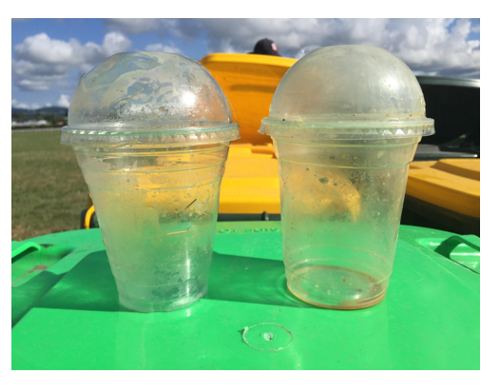Describing how packaging breaks down
There are numerous terms to describe how different materials break down and as a consumer this can often be confusing and sometimes misleading. Below are a few common terms that lead to confusion around disposal of products and packaging.
Degradable
Degradable items don't have living organisms as a crucial part of the breakdown process. Degradable bags cannot be classed as biodegradable or compostable. Instead, chemical additives used in the plastic allow the bag to break down quicker than a standard plastic bag usually would.
Note that these types of plastics break down into smaller pieces of plastic (microplastics). Technically everything degrades… and all plastics will degrade over time.
Biodegradable
Biodegradable plastics need living organisms to break down (i.e. fungus, bacteria) and often require specific conditions. This usually means commercial processing, but not all commercial plants can accept biodegradable plastics. Check your Council's website.
If sent to landfill, biodegradable plastics break down anaerobically (without oxygen) and release methane gas, a greenhouse gas that has a warming capacity 21 times more powerful than carbon dioxide. Landfills vary in their design and while some allow biodegradable materials to break down and have a system to capture the methane produced, some are designed so that nothing breaks down. If a material is stated as biodegradable it should include the environment it breaks down in (ie home compost or industrial compost) and provide a certification to back this claim up.
Compostable
Material will break down into natural elements in a compost environment, leaving no toxicity. Compostable is a subset of biodegradable.
Home compostable - Packaging that is labelled as Home Compostable must meet the requirements of breaking down in a home compost environment. That is, similar temperature and time frames as it takes food waste to break down. Generally, this is expected to occur in 90 days.
Commercially Compostable – Commercially compostable plastics are often made from plants so are better in their production than petroleum-based plastics. But packaging that is labelled as commercial compostable needs specific conditions to biodegrade and will not break down in a home composting system.
No council green bins in Aotearoa accept compostable packaging (with the exception of Council approved food caddy bins in some areas)
Composting standards
To date there is no agreed New Zealand standard for compostable packaging and food service ware. In the absence of a New Zealand composting standard there are several overseas standards that are recognised in Aotearoa. For more information visit WasteMINZ
The main thing to be aware of is that there are different standards for 'Commercially compostable' and 'Home compostable'.
There are currently varying degrees of success for both 'Commercially compostable' and 'Home compostable' packaging, as real life settings are often different to the lab based testing used to determine whether an item meets these standards.
Issues with commercially compostable packaging
Many commercial facilities do not accept compostable plastics due to a number of issues:
- Resource consents can limit or restrict the materials they accept.
- Litter becomes an issue as lightweight packaging is easily blown away.
- Contamination (unwanted materials)
- Unable to identify what the material is – some recyclable plastics and commercially compostable plastics look the same
- The facility’s processing time – commercially compostable plastics take longer to process than green waste.
- Issues with ratios of materials – facilities have to balance the nitrogen-rich materials (food and garden waste) with carbon-rich materials such as compostable packaging)
- Organic labelling restrictions – if the facility wants to label the compost that comes out of the system as organic, they cannot include any PLA (polylactic acid a plant based plastic).
Investigating the energy and resource use of products shows that reusable items always require fewer resources than single use items. For example, it takes energy to produce, transport and use an item and then takes energy to transport and dispose of an item. If the item is reusable, it can loop around numerous times before being disposed of. If it is a single use item, it may only be used for a matter of minutes before being disposed of.

One of these cups is commercially compostable and one is recyclable.
Waterproof and heat tolerant PLA plastic packaging made from polylactic acid is transparent and resembles oil-derived PET (polyethylene terephthalate). It is claimed to be compostable, but only with success in anaerobic digesters. PLA packaging (using resin recycling ID code 7) is often accidentally mixed with PET (code 1), because of similar appearance, which then makes the PET lower value for recycling and unviable.
What consumers can do
- The best thing consumers can do is avoid all forms of single-use packaging where possible. This could be by purchasing loose or in reusable packaging, ie your own containers or swappable containers. At the end of the day, commercially compostable packaging is still a single-use item, so uses a lot of energy and resources to produce for the short period of time that it is used. Companies are swapping out disposable plastic with disposable compostable plastic which still has disposal issues and requires energy and resources to break down.
- When it is not possible to purchase without packaging, buy products with paper/cardboard packaging as you can compost this in your home compost system (for info on how to see one up see our Composting page).
- Home compostable plastic is also better than commercially compostable as uses less resources to dispose of and you don't have to have a facility in your area that accepts it. If you are buying home compostable packaging, check that it has some form of composting standard that backs up their claim.
- Commercially compostable plastics are generally least desirable as they require a facility that accepts them and if they are disposed of incorrectly can pose other issues: if they end up in the environment as litter, they break down slowly and pose the same risk to wildlife as traditional petroleum based plastics and if they are sent to landfill they can break down like food waste and release methane gas, which contributes to global warming.
Pet Poo
There are a couple of sustainable options for pet poo - you can get certified home compostable dog poo bags. Be aware that pet poo needs to be composted in a separate system from a normal home compost and the end result used on flowers and trees not fruit and veg. You can make your own pet poo home compost system or purchase one.
Zing Bokashi offers a product called EnsoPet which provides a simple and hygienic way to compost pet waste. Some Councils offer EnsoPet products at a reduced cost - ask your local Council if it sells these products.
Please check with your local council before disposing of pet poo in your kerbside bin.

